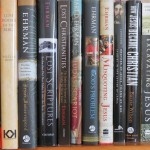I think it’s important that readers have a chance to assess a writer based on the writer’s own influences. The contents of a writer’s own bookshelves tell you something about the core perspectives of the person.
(Notice how I made the assumption that writers have more than one bookshelf!)
The books related to Christianity that I resonate most strongly with are books that are written for a lay audience by highly respected academic researchers who are not afraid to ask difficult questions, and are not afraid to cross the tightly drawn lines that artificially separate academic disciplines from each other. (As one example, biblical scholars and systematic theologians and religious studies scholars often won’t speak to each other.)
In other words, I like books that are clearly written, well researched, and inter-disciplinary.
I write notes all over my books, which is why I try to buy books rather than borrow them from the library. I’m on a budget, though, so I look for good reference material in used bookstores, etc. I’ve never met a dictionary I didn’t like.
A lot of today’s progressive Christians are reading books by Marcus Borg, John Dominic Crossan, and John Shelby Spong. I have books by these authors on my bookshelves, but these aren’t the books I go back to, and these aren’t the books I would recommend. These well-respected scholars are trying to reenvision Christianity, and I respect their motives, but I disagree with their suggestions about how to do it. I don’t think they’re asking the right questions.
One book I really like is York University professor Barrie Wilson’s How Jesus Became Christian (Toronto: Random House Canada, 2008). Don’t be put off by the cover, which is really, really dreadful (sorry Dr. Wilson!), and is a good example of why authors should try to get “veto rights” in their publishing contract for the title and the book design. Interestingly, Wilson says he was raised Episcopalian, but converted to Judaism because of the latter’s emphasis on praxis rather than “belief.” I’ve been wondering if the word he was really looking for was “fideism” (blind faith) rather than “belief.”
I also like Bart Ehrman’s books. He has written a lot of material for lay audiences, and some of it has enraged conservative and evangelical Christians. (After his 2005 book Misquoting Jesus became a hot seller, angry rebuttals in book form began to appear.) I don’t agree with Ehrman’s interpretation of Jesus as an apocalyptic prophet, but at least he’s not afraid to boldly outline the many inconsistencies and competing agendas of the biblical authors and their early Christian followers. Ehrman, like Wilson, has allowed his research to affect his personal life. In his youth, Ehrman was a devout evangelical Christian. He is now an agnostic.
I enjoyed Elaine Pagels’s 1988 book Adam, Eve, and the Serpent (New York: Vintage-Random House, 1988). Her historical synthesis was daring for the time, and her conclusions were controversial. (She dared to suggest that Christianity ought to reappraise Augustine’s “singular dominance” in Western Christianity.) Pagels is better known, though, for her work on the Nag Hammadi texts, and the Gospel of Thomas in particular. I would like to emphasize here — strongly, and in bold letters — that I, personally, am not a Gnostic. As I continue to post in the future on this blog, it will become clear why I feel I must clearly state that I do not hold Gnostic beliefs. (I guess I’m a little touchy because some Christians I’ve encountered who ought to know better, because they’re experts in their fields, have an unfortunate tendency to conflate Gnosticism with anything non-Newtonian. I don’t think this is an acceptable scholarly attitude in the new era of quantum entanglement/non-locality.)
I also really enjoy reading the bimonthly magazine Biblical Archaeology Review, which is available on good newsstands, including Chapters/Indigo. Ya gotta love editor Herschel Shanks’s pluckiness. Plus the photographs and maps that accompany the articles add an interesting dimension to the material. (As I mentioned in my profile, I come from a family of teachers and artists, so I’m drawn to educational materials that have a strong visual component.)
One last reference source I should mention is the Bible. In my research, I mostly use The New Oxford Annotated Bible: New Revised Standard Version with Apocrypha and The Jewish Study Bible: Featuring the Jewish Publication Society TANAKH Translation. Both these Bibles include extensive footnotes and scholarly articles. The translations are based on the most current and most comprehensive translation methods. No translation of the Bible is written in stone. I use the Bible as historical source material, not as “inviolable truth” or the literal “Word of God.” There’s good stuff in the Bible, but there’s also some stuff that’s gotta go. When I say it’s “gotta go,” I don’t mean it should be physically removed from the Bible, because that would be the same thing as burning books, and burning books is too close to fascism, if you ask me. I mean there are parts of the Bible that need to be reappraised in light of what they actually say about our relationship with God. We need to be honest about what some parts say, and we need to decide whether or not those parts can be “redeemed.”
That was kind of long and boring, but I’m trying to show that I hold the methods of historical research and scientific research in high regard.
This is why it may come as a shock to you to learn that my first calling (well, my second calling, actually — beginning in 1983, when I became pregnant with my first child, my highest calling has always been motherhood) . . . my primary spiritual calling is my ongoing commitment as a Christian mystic.
Yup. I’m a scientifically oriented, liberal, blond, United Church mystic.
Now there’s an oxymoron for you.
Have a great day!




